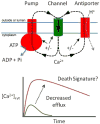The ins and outs of cellular Ca(2+) transport
- PMID: 21865080
- PMCID: PMC3230696
- DOI: 10.1016/j.pbi.2011.08.001
The ins and outs of cellular Ca(2+) transport
Abstract
The cytoplasmic Ca(2+) signals that participate in nearly all aspects of plant growth and development encode information as binary switches or information-rich signatures. They are the result of influx (thermodynamically passive) and efflux (thermodynamically active) activities mediated by membrane transport proteins. On the influx side, confirming the molecular identities of Ca(2+)-permeable channels is still a major research topic. Cyclic nucleotide-gated channels and glutamate receptor-like channels are candidates well supported by evidence. On the efflux side, CAX antiporters and P-type ATPase pumps are the principal molecular entities. Both of these active transporters load Ca(2+) into specific compartments and have the potential to reduce the magnitude and duration of a Ca(2+) transient. Recent studies indicate calmodulin-activated Ca(2+) pumps in endomembrane systems can dampen the magnitude and duration of a Ca(2+) transient that could otherwise grow into a Ca(2+) cell death signature. An important challenge following molecular characterization of the influx and efflux pathways is to understand how they are coordinately regulated to produce a Ca(2+) switch or encode specific information into a Ca(2+) signature.
Published by Elsevier Ltd.
Figures

Similar articles
-
Calcium-permeable channels in plant cells.FEBS J. 2011 Nov;278(22):4262-76. doi: 10.1111/j.1742-4658.2011.08369.x. Epub 2011 Oct 24. FEBS J. 2011. PMID: 21955583 Review.
-
Regulation and Role of Store-Operated Ca2+ Entry in Cellular Proliferation.In: Kozak JA, Putney JW Jr, editors. Calcium Entry Channels in Non-Excitable Cells. Boca Raton (FL): CRC Press/Taylor & Francis; 2018. Chapter 12. In: Kozak JA, Putney JW Jr, editors. Calcium Entry Channels in Non-Excitable Cells. Boca Raton (FL): CRC Press/Taylor & Francis; 2018. Chapter 12. PMID: 30299656 Free Books & Documents. Review.
-
Calcium channels and transporters: Roles in response to biotic and abiotic stresses.Front Plant Sci. 2022 Sep 8;13:964059. doi: 10.3389/fpls.2022.964059. eCollection 2022. Front Plant Sci. 2022. PMID: 36161014 Free PMC article. Review.
-
Tuning outer segment Ca2+ homeostasis to phototransduction in rods and cones.Adv Exp Med Biol. 2002;514:179-203. doi: 10.1007/978-1-4615-0121-3_11. Adv Exp Med Biol. 2002. PMID: 12596922 Review.
-
Genes for calcium-permeable channels in the plasma membrane of plant root cells.Biochim Biophys Acta. 2002 Aug 31;1564(2):299-309. doi: 10.1016/s0005-2736(02)00509-6. Biochim Biophys Acta. 2002. PMID: 12175911 Review.
Cited by
-
Dual function of overexpressing plasma membrane H+-ATPase in balancing carbon-water use.Sci Adv. 2024 Nov 8;10(45):eadp8017. doi: 10.1126/sciadv.adp8017. Epub 2024 Nov 8. Sci Adv. 2024. PMID: 39514663 Free PMC article.
-
Thriving under Salinity: Growth, Ecophysiology and Proteomic Insights into the Tolerance Mechanisms of Obligate Halophyte Suaeda fruticosa.Plants (Basel). 2024 May 31;13(11):1529. doi: 10.3390/plants13111529. Plants (Basel). 2024. PMID: 38891337 Free PMC article.
-
Decoding Arabidopsis thaliana CPK/SnRK Superfamily Kinase Client Signaling Networks Using Peptide Library and Mass Spectrometry.Plants (Basel). 2024 May 27;13(11):1481. doi: 10.3390/plants13111481. Plants (Basel). 2024. PMID: 38891291 Free PMC article.
-
Genome-Wide Exploration and Expression Analysis of the CNGC Gene Family in Eggplant (Solanum melongena L.) under Cold Stress, with Functional Characterization of SmCNGC1a.Int J Mol Sci. 2023 Aug 22;24(17):13049. doi: 10.3390/ijms241713049. Int J Mol Sci. 2023. PMID: 37685854 Free PMC article.
-
The CALCINEURIN B-LIKE 4/CBL-INTERACTING PROTEIN 3 module degrades repressor JAZ5 during rose petal senescence.Plant Physiol. 2023 Sep 22;193(2):1605-1620. doi: 10.1093/plphys/kiad365. Plant Physiol. 2023. PMID: 37403193 Free PMC article.
References
-
- Scrase-Field SA, Knight MR. Calcium: just a chemical switch? Curr Opin Plant Biol. 2003;6:500–506. - PubMed
-
- McAinsh MR, Pittman JK. Shaping the calcium signature. New Phytol. 2009;181:275–294. - PubMed
-
- Dodd AN, Kudla J, Sanders D. The language of calcium signaling. Annu Rev Plant Biol. 2010;61:593–620. - PubMed
-
- Kaplan B, Sherman T, Fromm H. Cyclic nucleotide-gated channels in plants. FEBS Lett. 2007;581:2237–2246. - PubMed
Publication types
MeSH terms
Substances
Grants and funding
LinkOut - more resources
Full Text Sources
Miscellaneous


